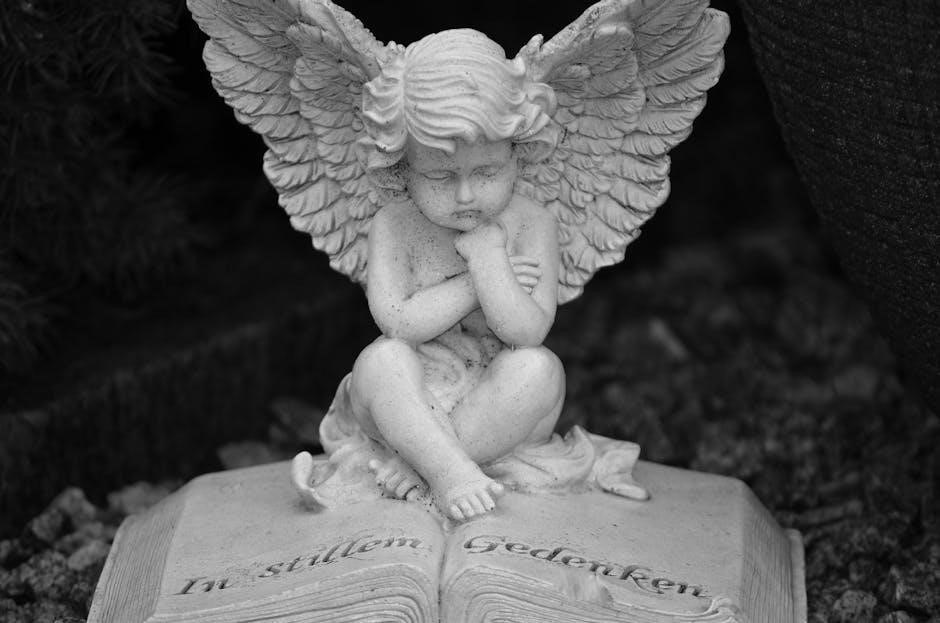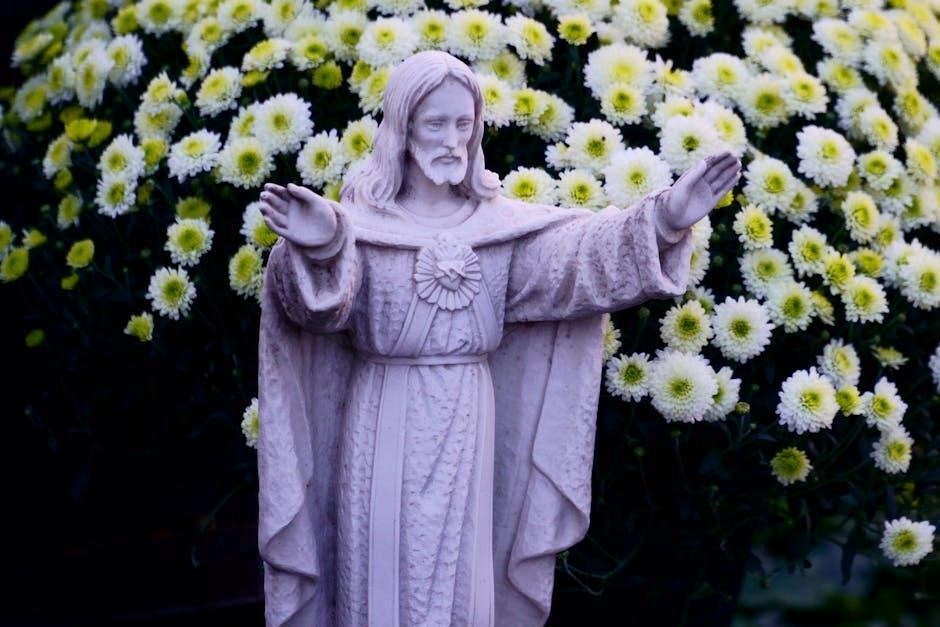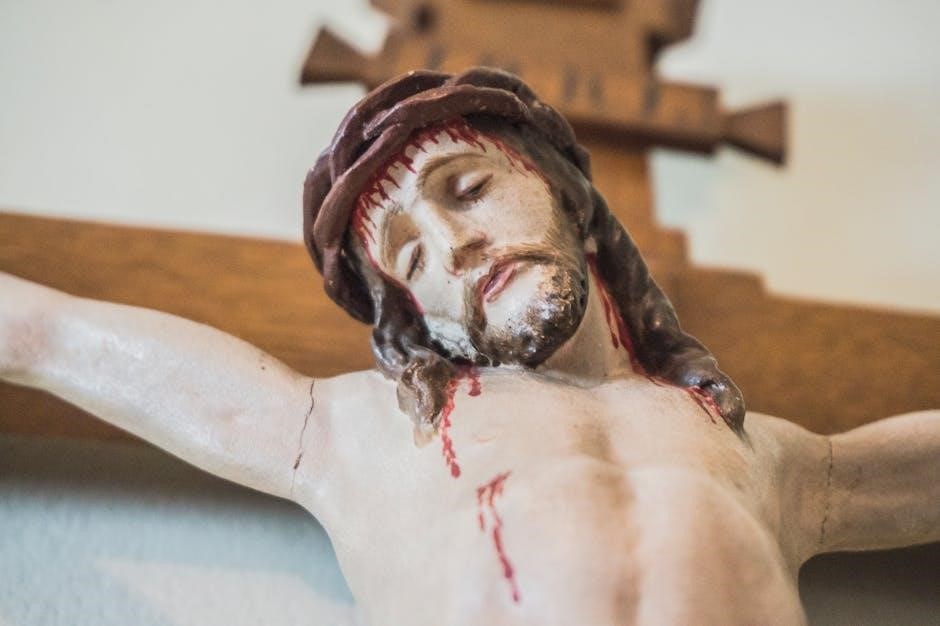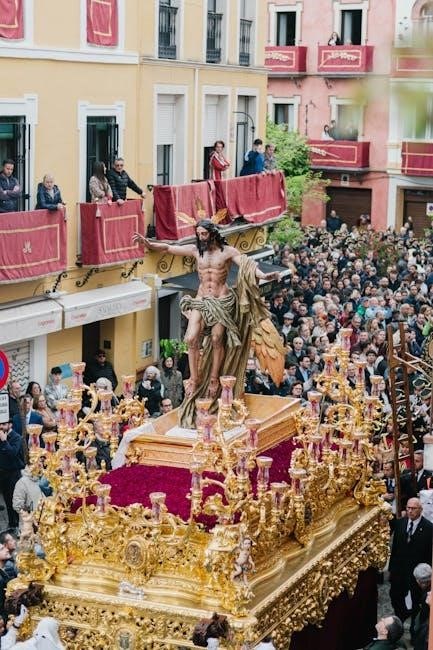
The last week of Jesus’ life is a pivotal period in Christian theology, marking the climax of His ministry with events leading to His crucifixion and resurrection.
Overview of Holy Week
Holy Week, also known as Passion Week, is the final week of Jesus’ life before His resurrection. It begins with His arrival in Bethany and culminates in His resurrection on Easter Sunday. Each day of Holy Week is significant, marking key events in Jesus’ journey to the cross. Sunday commemorates the Triumphal Entry into Jerusalem, while Monday highlights the cleansing of the Temple. Tuesday focuses on Jesus’ teachings and challenges to His authority. Wednesday marks the plot to kill Him, and Thursday remembers the Last Supper. Friday is the day of crucifixion, and Saturday observes His burial. Holy Week is a period of reflection and celebration for Christians, emphasizing the redemption achieved through Jesus’ sacrifice and resurrection.
Significance of the Final Week in Jesus’ Ministry
The final week of Jesus’ life holds profound theological and redemptive significance, marking the culmination of His earthly ministry. It is during this period that Jesus’ purpose—to sacrifice Himself for humanity’s sin—is fully realized. The events of Holy Week, from the Triumphal Entry to the Resurrection, are central to Christian faith, illustrating God’s love, redemption, and victory over sin and death. This week also highlights Jesus’ fulfillment of prophetic expectations and His divine authority. For believers, it serves as a powerful reminder of the atonement and salvation achieved through Christ’s sacrifice. The final week underscores the essence of Jesus’ mission, making it the cornerstone of Christian theology and devotion.

Saturday: Arrival in Bethany
Jesus arrived in Bethany, where He was welcomed with a supper prepared in His honor. This marked the beginning of His final week, filled with profound events.
Jesus’ Arrival in Bethany (John 12:1)
Jesus arrived in Bethany, a small village near Jerusalem, six days before the Passover. This visit marked the beginning of His final week, filled with significant events leading to His crucifixion. Upon His arrival, He was greeted with a supper prepared in His honor, reflecting the deep affection and respect of the people. Lazarus, whom Jesus had raised from the dead, was among those present, symbolizing Jesus’ power over death. This gathering in Bethany set the stage for the dramatic events that would unfold in Jerusalem, showcasing Jesus’ divine mission and the growing tensions that would lead to His ultimate sacrifice.
The Supper Prepared for Jesus
In Bethany, a supper was prepared in Jesus’ honor, hosted by Lazarus, Martha, and Mary. This intimate gathering reflected the deep devotion of these followers, who had experienced Jesus’ miraculous power firsthand. Martha, known for her hospitality, served the meal, while Mary anointed Jesus’ feet with costly perfume, an act of profound worship. This gesture, though criticized by Judas for its extravagance, was defended by Jesus as a preparation for His burial. The supper symbolized the love and gratitude of those who recognized Jesus’ divine mission, contrasting with the growing opposition that would soon lead to His arrest and crucifixion.

Sunday: Triumphal Entry into Jerusalem
Jesus entered Jerusalem on a donkey, fulfilling prophecy, as crowds waved palms and shouted “Hosanna,” celebrating His arrival as the Messiah, marking Palm Sunday.
Jesus’ Entry on a Donkey
Jesus’ triumphal entry into Jerusalem began with His deliberate choice to ride a donkey, symbolizing humility and peace. This act fulfilled Zechariah’s prophecy, emphasizing His messianic role. The donkey, often associated with kingship in Jewish tradition, contrasted with the grandeur of earthly rulers, highlighting Jesus’ divine yet humble nature. By selecting this mode of entry, Jesus underscored His mission of salvation and His rejection of worldly power. The simplicity of the donkey also reflected His teachings on meekness and service, setting the tone for the week’s events leading to His crucifixion.
Crowds Shouting “Hosanna”
As Jesus entered Jerusalem, the crowds enthusiastically shouted “Hosanna,” a Hebrew expression meaning “Save now!” This outburst of praise reflected their recognition of Jesus as the Messiah and their hope for deliverance. The people waved palm branches, symbolizing victory and peace, and spread cloaks on the road, creating a royal carpet. The chants of “Hosanna” echoed through the city, marking a moment of widespread acknowledgment of Jesus’ divine identity. However, this celebration also heightened tensions with religious leaders, who viewed it as a challenge to their authority. The phrase “Hosanna” became a declaration of faith, capturing the essence of Jesus’ mission and the anticipation of salvation. This event is commemorated on Palm Sunday, symbolizing the triumphal entry and the people’s joyful reception of Jesus.
Jesus Weeps Over Jerusalem
As Jesus approached Jerusalem, He was overcome with emotion, weeping over the city. Despite the joyful reception by the crowds, Jesus foresaw Jerusalem’s impending destruction and the suffering of its people. His tears reflected deep sorrow and compassion, as He lamented the city’s failure to recognize the time of God’s visitation. This moment highlights Jesus’ divine foresight and His profound love for humanity. The contrast between the celebratory shouts of “Hosanna” and Jesus’ tears underscores the complexity of His mission and the tragic consequences of spiritual blindness. This event serves as a poignant reminder of God’s mercy and the importance of repentance, offering a glimpse into Jesus’ heart of sorrow and longing for His people’s salvation.

Monday: Cleansing the Temple
Jesus cleansed the Temple, overturning tables and driving out merchants, restoring it as a house of prayer. He also withered a fig tree, symbolizing judgment on unfruitfulness.
Withering of the Fig Tree
On Monday, Jesus encountered a fig tree without fruit. He cursed it, and it withered, symbolizing God’s judgment on spiritual barrenness. This act underscored Jesus’ divine authority and call for true spiritual fruitfulness, aligning with His cleansing of the Temple. The fig tree, often representing Israel, highlighted the need for genuine faith and repentance. This event, along with the Temple cleansing, emphasized the urgency of spiritual renewal and prepared the people for Jesus’ forthcoming sacrifice. The withering of the fig tree remains a powerful allegory for the consequences of unfruitful spiritual lives, reinforcing the central message of Jesus’ ministry during His final week in Jerusalem.
Second Cleansing of the Temple
On Monday of Holy Week, Jesus entered the Temple in Jerusalem and encountered merchants selling animals and exchanging money. He overturned the tables, condemning the exploitation and corruption that had turned a sacred space into a marketplace. This act, known as the second cleansing of the Temple, was a bold declaration of Jesus’ authority and His desire to restore the Temple as a house of prayer. The event symbolized His rejection of religious hypocrisy and the exploitation of faith for profit. It also highlighted the need for purity and authenticity in worship, drawing both amazement and anger from the people and religious leaders alike.

Tuesday: Teaching in the Temple
On Tuesday, Jesus taught openly in the Temple, engaging the crowds and challenging the religious leaders, setting the stage for growing tension and confrontation.
Jesus’ Authority Challenged
Daily, religious leaders questioned Jesus’ authority, seeking to undermine His influence. They demanded to know by what power He acted, attempting to trap Him with legalistic arguments. Jesus responded with parables, such as the parable of the wicked tenants, which implicitly criticized their rejection of God’s messengers. This confrontation escalated tensions, highlighting the growing opposition to His teachings. The leaders’ challenge was not just about power but about controlling the narrative and maintaining their religious dominance. Jesus’ unwavering stance deepened their resolve to silence Him, setting the stage for the events that would unfold later in the week.
Teachings and Parables
During His final days in the Temple, Jesus delivered profound teachings and parables that underscored His divine mission. He spoke of the Kingdom of God, emphasizing its demands and mysteries. The parable of the talents highlighted faithfulness and stewardship, while the parable of the vineyard revealed God’s judgment on those who rejected His messengers. Jesus’ teachings were both convicting and redemptive, calling His listeners to repentance and faith. These lessons were not mere stories but revelations of God’s plan, reinforcing the urgency of His message. Through these teachings, Jesus prepared His disciples for His impending departure and the challenges they would face, ensuring His truth would endure beyond His physical presence.
Wednesday: The Plot to Kill Jesus
Judas agreed to betray Jesus for 30 pieces of silver, and the Sanhedrin finalized their plan to arrest and execute Him, fearing His growing influence.
Judas Agrees to Betray Jesus
Judas Iscariot, one of Jesus’ twelve disciples, secretly agreed to betray Him for 30 pieces of silver. This decision marked a turning point in the Passion narrative, as it set in motion the events leading to Jesus’ arrest and crucifixion. The betrayal was motivated by a combination of greed and disillusionment, as Judas had become increasingly dissatisfied with Jesus’ teachings and the direction of His ministry. The act of betrayal was prearranged with the Sanhedrin, who sought to eliminate Jesus due to His growing influence and perceived threat to their authority; This pact not only sealed Jesus’ fate but also fulfilled biblical prophecies, highlighting the divine plan unfolding during Holy Week.
The Sanhedrin’s Plan
The Sanhedrin, the Jewish religious council, plotted to eliminate Jesus due to His teachings and miracles, which they saw as threats to their authority and traditions. They sought to arrest and execute Him quietly to avoid stirring public unrest, especially during Passover when Jerusalem was crowded. Caiaphas, the high priest, played a key role, advocating for Jesus’ death as a means to preserve national stability. The Sanhedrin’s plan involved collaboration with Judas, who provided the means to capture Jesus away from the public eye. This conspiracy underscored the religious leaders’ opposition to Jesus and their determination to maintain their power over the Jewish community.

Thursday: The Last Supper
On Thursday, Jesus shared the Last Supper with His disciples, a Passover meal symbolizing the New Covenant. This intimate gathering marked His final moments before crucifixion.
Institution of the Eucharist
The institution of the Eucharist occurred during the Last Supper, where Jesus transformed bread and wine into His body and blood, symbolizing the New Covenant. This sacred ritual, rooted in the Passover tradition, marked a profound shift in worship, commemorating His sacrifice. Jesus’ words, “This is my body” and “This cup is the new covenant in my blood,” established the Eucharist as a central Christian sacrament. The Eucharist signifies unity with Christ and remains a cornerstone of Christian worship, reinforcing the spiritual bond between believers and their Savior.
Jesus Washes the Disciples’ Feet
During the Last Supper, Jesus demonstrated profound humility by washing the disciples’ feet, a task typically performed by servants. This act shocked the disciples, especially Peter, who initially refused, believing it was beneath Jesus. Jesus replied, “If I do not wash you, you have no part with me,” emphasizing the necessity of humility and servanthood. After washing their feet, Jesus instructed them to follow His example, teaching that true leadership is rooted in selfless love and service; This moment underscored Jesus’ commitment to modeling a life of compassion and humility, leaving an indelible mark on the disciples’ understanding of His mission and their own calling to serve others.
Jesus’ Farewell Discourse
In the Upper Room, during the Last Supper, Jesus delivered a profound farewell discourse to His disciples. Recorded in John 13-17, this intimate teaching emphasized love, unity, and the promise of the Holy Spirit. Jesus began by washing their feet, demonstrating humility, then He spoke of His impending departure, reassuring them of His continued presence through the Spirit. He gave the new commandment to “love one another as I have loved you,” reinforcing the essence of His teachings. Jesus also prayed for His disciples and all future believers, asking for unity and protection in a world hostile to His message. This discourse provided comfort and guidance, preparing the disciples for His absence and empowering them to continue His work. It remains a cornerstone of Christian theology, highlighting Jesus’ deep love and concern for His followers.

Friday: The Crucifixion
Jesus was nailed to the cross at Golgotha, enduring immense suffering as a sacrifice for humanity’s sins. His death marked the ultimate act of divine love and atonement.
The crucifixion, a central event in Christian theology, symbolized the fulfillment of Old Testament prophecies and the climax of Jesus’ earthly mission to redeem humanity through His sacrifice.
Jesus’ Trial and Condemnation
Jesus’ trial was a series of legal proceedings orchestrated by religious leaders to condemn Him. After His arrest in Gethsemane, He was taken before the high priest, Caiaphas, where false witnesses testified against Him. Jesus remained silent until questioned directly about His identity as the Messiah, to which He affirmed, leading to accusations of blasphemy. The Sanhedrin delivered Him to Pontius Pilate, the Roman governor, who, despite finding no fault in Jesus, succumbed to the crowd’s demand for crucifixion. Herod Antipas also examined Jesus but found no basis for charges. The trials underscored the collusion between religious and political powers, fulfilling ancient prophecies and highlighting the injustice of His condemnation.
The Crucifixion and Burial
Jesus was crucified on Golgotha, a hill outside Jerusalem, as a form of public execution. Nails were driven into His hands and feet, and He was given vinegar and gall to drink. The crucifixion lasted six hours, during which He uttered final words, including a prayer of forgiveness for His executioners. At His death, darkness fell, and the temple veil tore, symbolizing the end of the old covenant. Jesus’ body was taken down and buried by Joseph of Arimathea and Nicodemus, who wrapped it in linen and placed it in a nearby tomb. This act of burial fulfilled prophetic expectations, setting the stage for His resurrection on the third day.

Saturday: Jesus’ Burial
Jesus’ burial occurred on Saturday, with Joseph of Arimathea and Nicodemus wrapping His body in linen and placing it in a tomb, fulfilling prophetic expectations.
Jesus in the Tomb
On Saturday, Jesus’ body rested in the tomb, fulfilling the Sabbath rest. Joseph of Arimathea and Nicodemus wrapped His body in linen and placed it in a tomb. This act of burial was a fulfillment of prophetic expectations, showcasing God’s sovereignty even in death. The disciples and followers grieved, unaware of the impending resurrection. The tomb symbolized the temporary end of Jesus’ earthly ministry, yet it held the promise of redemption. This day marked a period of stillness, as all awaited the climax of God’s plan. Theological significance lies in the rest, reflecting divine control over life, death, and resurrection.
The Sabbath Rest
The Sabbath following Jesus’ burial was a day of rest, adhering to Jewish tradition. His disciples and followers observed the Sabbath, refraining from work, as commanded in the Law. This day symbolized trust in God’s plan, even amidst grief and uncertainty. The Sabbath rest underscored the completion of Jesus’ earthly ministry and the anticipation of divine action. It was a period of stillness, reflecting the theological significance of God’s sovereignty over time and events. The disciples, though unaware, were part of a larger narrative unfolding according to God’s will. This rest prepared the way for the resurrection, the ultimate fulfillment of Jesus’ mission.

Sunday: The Resurrection
The resurrection of Jesus on Sunday marked the culmination of Holy Week, demonstrating God’s divine power and fulfilling the promise of eternal life through Christ.
The Empty Tomb
The empty tomb is a central event in Holy Week, symbolizing Jesus’ victory over death. Early on Sunday morning, women discovered the tomb empty, with burial cloths neatly folded. An angel announced Jesus’ resurrection, fulfilling Old Testament prophecies. This moment marked the climax of Holy Week, transforming sorrow into joy. The empty tomb signifies the divine power of God, demonstrating Jesus’ triumph over sin and death. It serves as a profound reminder of the Christian hope of eternal life. The discovery of the empty tomb is a pivotal moment, reshaping the disciples’ understanding of Jesus’ mission and identity. This event remains a cornerstone of Christian faith, celebrating the resurrection’s transformative power.
Appearances of the Risen Jesus
Following the resurrection, Jesus appeared to His followers, confirming His victory over death. Mary Magdalene was the first to encounter Him, and later, He appeared to the disciples on the road to Emmaus. These encounters revealed His divine nature and reignited their faith. Jesus also appeared to Thomas, offering proof of His resurrection and strengthening His disciples’ belief. These appearances demonstrated Jesus’ power and solidified the foundation of Christian faith. They emphasized the fulfillment of Old Testament prophecies and the promise of eternal life. The risen Jesus’ interactions with His followers transformed their fear into courage, preparing them to spread His message globally. These events remain central to the Christian narrative, celebrating the triumph of life over death.
Theological Significance of the Last Week
The last week of Jesus’ life underscores His fulfillment of prophecy, divine purpose, and the foundation of Christian theology, highlighting sacrifice, redemption, and the New Covenant.
The Passion and Atonement
The Passion of Jesus, culminating in His crucifixion, represents the ultimate act of love and sacrifice, fulfilling God’s plan for humanity’s redemption. Through His willingness to endure suffering and death, Jesus bore the sins of the world, providing atonement for all people. This act of selfless love demonstrated God’s mercy and justice, establishing a New Covenant between God and humanity. The Passion narrative, including the crucifixion and resurrection, is central to Christian theology, emphasizing Jesus’ role as the Savior who reconciles humanity to God. His sacrifice on the cross symbolizes the forgiveness of sins and the triumph over death, offering eternal life to believers.
Resurrection and Its Implications
The resurrection of Jesus on Easter Sunday marks the climax of Holy Week, demonstrating His power over death and sin. The empty tomb and eyewitness accounts of His appearances confirmed His divine authority and fulfilled Old Testament prophecies. This event transformed the disciples, empowering them to spread His teachings fearlessly. The resurrection signifies the hope of eternal life for believers, validating Jesus’ sacrifice as the atonement for humanity’s sins. It also established the foundation of the Christian Church, inspiring faith and renewal. The implications of the resurrection extend beyond historical events, offering spiritual rebirth and the promise of salvation. This miracle remains central to Christian belief, celebrating the triumph of life over death and the eternal hope it provides.

Cultural and Historical Impact
The last week of Jesus’ life has profoundly shaped culture, inspiring countless works of art, literature, and music. It remains a cornerstone of Christian traditions globally, influencing faith and history for centuries.
Holy Week Traditions
Holy Week traditions commemorate the last week of Jesus’ life, deeply rooted in Christian faith and culture. Many churches observe special liturgical services, processions, and reenactments of key events, such as the Triumphal Entry on Palm Sunday. Families often participate in prayer vigils, fasting, and reflective devotions. In some cultures, Passion Plays dramatize the events leading to Jesus’ crucifixion and resurrection. These traditions aim to deepen spiritual connection and remembrance of Christ’s sacrifice. They also foster community bonding through shared rituals and reflections, making Holy Week a time of profound spiritual renewal and historical remembrance.
Artistic and Literary Representations
The last week of Jesus’ life has inspired countless artistic and literary works, reflecting its profound impact on human culture. From paintings like Leonardo da Vinci’s The Last Supper to films such as The Passion of the Christ, these depictions bring the story to life. Literary works, including novels and plays, explore the emotional and theological depth of the events. Passion Plays, reenacted in many communities, are a traditional way to commemorate the week. These artistic expressions not only preserve the narrative but also invite reflection and connection, making the story accessible across generations and cultures.